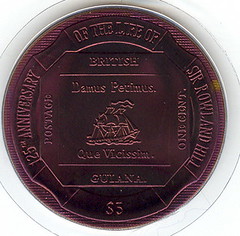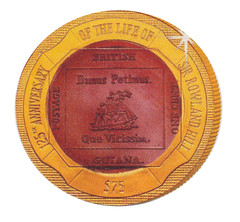
PREV ARTICLE
NEXT ARTICLE
FULL ISSUE
PREV FULL ISSUE
MORE ON THE ONE-CENT MAGENTA STAMPYossi Dotan writes: Regarding the 1856 British Guiana One-Cent Magenta Stamp, there is also a numismatic angle: it was depicted on two coins of the British Virgin Islands issued in 2004 that commemorated the 125th anniversary of the death of Rowland Hill, the inventor of the postage stamp—a red titanium 5-dollar coin (KM#284) and a bimetallic 75-dollar coin composed of a red titanium core in a gold ring (KM#285). The red color of the titanium alludes to the magenta color of the stamp. Attached are images of the two coins, that of the 75-dollar coin was taken from a sales promotion by the Pobjoy Mint. The E-Sylum of October 23, 2005 included a description of the coins. They were listed in my book Watercraft on World Coins, Volume II: America and Asia, 1800-2008 because of the ship on the stamp. She is the vessel that was shown on British Guiana's colonial badge.  
Thanks! David Sundman forwarded a New York Times article about the exhibit. Here's an excerpt. -Editor
Mr. Weitzman, 73, pretty much gave up stamp collecting in his late teens and went on to achieve notoriety and wealth designing shoes — strappy gladiator sandals, sultry thigh-high boots and dozens of others made from everything from cork to Lucite, even 24-karat gold. But Mr. Weitzman never forgot about the One-Cent Magenta, and he fulfilled his boyhood dream last year when he bought the stamp anonymously at auction for $9.5 million. His identity as the buyer was revealed on Thursday, the same day the stamp went on display at the National Postal Museum in Washington. Mr. Weitzman has lent the stamp to the museum for two and a half years. So for nearly a year, the man behind the Nudist, a sandal with thin straps and pin heels, has owned a stamp that is barely big enough to cover a birthmark on a supermodel. “The stamp looked so tiny,” he added. To some philatelists, the One-Cent Magenta is the “Mona Lisa” of stamps, perhaps not inscrutable but certainly incomparable. Die-hard collectors tend to be more interested in the back than the front, which has an image of a schooner and a Latin motto that is usually translated as “We give and we take in return.” It bears the initials from a clerk at the post office where it was originally sold and from past owners. There is even an unusual-looking star, yet another mark of a past owner. Unlike the famous Inverted Jenny, the 1918 United States stamp that was mistakenly printed with an upside-down biplane known as a Jenny, the One-Cent Magenta is not just rare, it is unique. There are 100 Inverted Jennies. As Mr. Weitzman learned as a child, no other One-Cent Magentas are known to exist, and until it went on a tour arranged by Sotheby’s before the sale last year, it had not been seen in public since the 1980s. David Sundman adds: The buyer also bought my brother Donald Sundman's Jenny Invert plate block. Don owns Mystic Stamp Company in Camden, New York. To read the complete article, see:
To read the earlier E-Sylum articles, see:
Wayne Homren, Editor The Numismatic Bibliomania Society is a non-profit organization promoting numismatic literature. See our web site at coinbooks.org. To submit items for publication in The E-Sylum, write to the Editor at this address: whomren@gmail.com To subscribe go to: https://my.binhost.com/lists/listinfo/esylum All Rights Reserved. NBS Home Page Contact the NBS webmaster 
|
